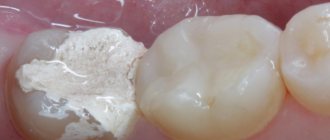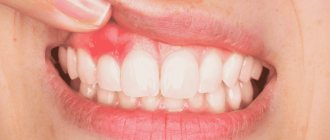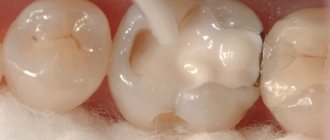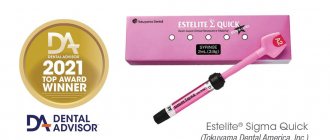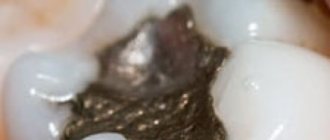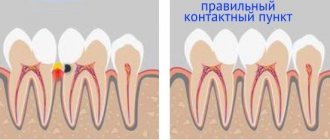Types of tooth extensions
Restoration
The photopolymer restoration method is suitable for a minor degree of destruction - carious cavity, chip, crack, small tooth size. The photopolymer is non-toxic and durable; with proper care it will last up to 7 years. The color of the material is selected individually, depending on the shade of the patient’s enamel.
Stages:
- examination of the oral cavity, selection of a suitable composite;
- cleaning teeth from hard and soft plaque, isolating the working area with protective pads;
- layer-by-layer application of photopolymer material using an ultraviolet lamp for curing, giving the tooth surface anatomical details.
Extension on a pin
The method is suitable for a tooth with severe destruction; the main thing is to preserve a healthy root. For this option, the same photopolymer material is used, and a titanium or fiberglass rod is used as a base. The cost of building a tooth on a post will be higher as the amount of work increases.
Stages:
- examination of the oral cavity and x-rays - cysts are often found on the roots of teeth with such trauma, which must be removed before restoration begins;
- removal of hard and soft plaque, old fillings;
- implantation of a pin into the root canal and layer-by-layer application of a composite material using a curing lamp;
- polishing the surface and creating anatomical details - tubercles, depressions, fissures.
Sometimes teeth extensions include smile correction with veneers - thin ceramic plates. However, this procedure is called microprosthetics and does not quite fit into the category of extensions. When building up, artificial dental tissue is applied to the damaged tooth, which complements the real one. When working with veneers, you cannot “build up” the tooth surface with an onlay - it is created in the laboratory using individual impressions and glued to the ground surface of the tooth.
Make an appointment
Thank you, your application has been accepted!
Seal + pin = Error?!
Since 1792, dentists have been searching for the perfect tooth post. Almost 300 years have passed, and the mythical perfect pin has not been found. Is it really necessary?
Valentina Vladimirovna Khalyavka, general director and orthopedic dentist of the Dental Clinic “Dentist”, speaks about the problem of treating periodontal diseases. (Article from the archives of the magazine “Women’s Health” Copyright entirely belongs to dentist V.V. Khalyavka)
Features of dental pinning, or why specialists at the Dentist clinic prefer more modern tactics.
Filling with a pin - what is it?
Increasing the strength of a tooth means extending its life. One of
The most popular solution to this problem for a long time was the use of pins. They are a ready-made structure that looks like a threaded rod. After expanding the canal mechanically, the pin is fixed directly into the canal of the tooth root, with cement, or screwed in like a screw, after which the remaining stages of restoring the damaged tooth are carried out. A filling with a pin is very often used in practice by dental therapists without a crown and orthopedic dentists with a crown.
IMPORTANT:
Pinning teeth and covering them with a crown is a gross orthopedic mistake, as well as a therapeutic one, which in the future will lead the patient to tooth extraction with subsequent implantation. That is why the most modern dental centers opt for other technologies.
Crown or filling on a post.
The question of which is better, a pin with a filling or a crown, is still relevant for many dentists. However, clinic specialists
“Dentist”, based on long clinical studies and personal observational experience, consider the choice in favor of dental pinning to be unsafe and extremely harmful. In clinical studies, it was proven that a filling on a pin leads to the removal of teeth in 70% of patients. Extraction (removal) of teeth in the roots of which metal pins were installed was carried out in connection with a root fracture. The reason for this is that pinning negatively affects the biomechanics of the tooth. During the endodontic protocol (treatment), the canal is widened, which has an acceptable limit. When a pin is installed, the expansion of the canal goes beyond the permissible limits and the walls of the tooth root become very thin. Inserting a pin into the root leads to a wedging effect. When chewing, the action of external forces becomes excessive, deformations occur, which lead to rupture or fracture of the root. Extraction (removal) of teeth in the roots of which metal pins were installed was carried out due to a root fracture.
IMPORTANT:
According to specialists at the Dentist clinic, the use of pins in everyday practice is a gross mistake, which in the future will lead to tooth extraction.
Thanks to modern technologies and the use of the latest generation of light materials (Enamel and Estet-X), our doctors carry out large dental restorations without the use of pins
. Restorations, like fillings made from the latest generation materials, serve their owners for a long time, more than 15 years!
For teeth with severely damaged coronal parts, we recommend core inlays
made of metal, inlays made of composite materials and zirconium dioxide. These additional expenses will definitely pay off in that you will not soon have to resort to tooth extraction where a filling was previously installed on a pin, further installation of a bridge structure, or implantation. Patients fully support this approach and consider the clinic one of the best in Moscow, which is clearly reflected in their positive reviews.
What dangers and harm does dental pin therapy pose for patients?
I began my career as a therapist-orthopedist-dentist after graduating from dental institute and residency 25 years ago. Few people know that the work of a dentist of any specialty requires the doctor to have in-depth knowledge of physics, namely mechanics and biomechanics, strength of materials and chemistry. And this is not without reason. Did I surprise you?! The entire chewing function of the jaw apparatus operates and works according to the laws of physics. Ignorance by a dentist of the basics of physics and mechanics leads our patients to tooth extraction, breakage of orthopedic structures, rejection of implants, and everything that is called medical error!
Until now, I am faced with metal pins twisted into the canals of the tooth, a “dentist” and I see the consequences that lead to fracture of the roots of the teeth, decementing of crowns, bridges and always, as a result, removal! Patients pay special attention to the issue of preserving natural teeth. The desire to preserve teeth for a long time also increasingly extends to those teeth whose crowns are severely damaged.
IMPORTANT:
Patients are not certified specialists in the field of dentistry; they often do not understand the principles of this or that treatment path, and in fact they should not understand!! They turned to a specialist dentist who will explain, suggest and help!
And so the “walk through agony” begins. A song as old as the world that “dead teeth” (the nerve has been removed) are very fragile and they must be strengthened with a metal pin, or a non-metal one, it is simply necessary to reinforce them, since the filling will not hold, and crown and bridge! If today the dentist does not have knowledge and scientific evidence about the dangers of “pin therapy,” I will try to reach out to patients. After all, these are their teeth and they want to preserve them at any cost!
And how great it sounds: “A restored tooth with a pin will last much longer (at least 5-7 years) and will withstand increased chewing loads.
IMPORTANT:
The opinion that: “Restorations using root pins are a good treatment method that sufficiently ensures fixation of the restoration during orthopedic work” is deeply erroneous and has long been outdated!
Scientific research.
"Long-term clinical studies that have been conducted
Axelsson et al.
(1991) over a 15-year period clearly showed that pins and screws placed in the root canal had an adverse effect on the prognosis of the tooth. At the same time, a total of 71 teeth were removed from 59 patients, of which 48 teeth (69%) were removed after endodontic treatment and installation of a root pin. Extraction of these teeth was performed due to a root fracture. Also Eckerbom et al. (1991) indicated in their clinical studies, which were carried out over 5-7 years, that the rate of extraction of teeth in the roots of which metal pins were installed was higher than that of teeth without a root post.” All these research observations were always available, and each doctor could obtain reliable information if desired.
It has been proven that the root post:
- Does not stabilize the tooth root or strengthen it.
- Does not contribute to the retention of the filling in any situation.
- Does not contribute to the redistribution of load during chewing.
Consequences of the pin + filling design.
- Weakens the root due to its strong expansion.
- The pin + seal makes the structure heavier.
- Leads to root fracture - fracture.
- Removal followed by prosthetics and implantation.
- Corrosion of stainless steel pins, which leads to tooth root fracture.
Why do all pins negatively affect the root of the tooth?
From the physics course we know that all solids experience deformation: shear, compression, bending, torsion. Depending on the material, each item has its own margin of safety. Strength is the ability of a material to resist destruction and for everyone it has its own limit. When carrying out endodontic treatment, we are forced to intervene in the biomechanics of the tooth. Carry out instrumental treatment, namely expansion of the canal. But there is a permissible limit of expansion, beyond which we actually weaken the foundation of the tooth. The human tooth, like the bone (periodontal) in which it is located, experiences elastic deformation, compression and tension deformation during chewing, but perceives it adequately. But as soon as the action of external forces becomes excessive, plastic deformations occur, which lead to destruction.
IMPORTANT:
When installing a screw pin, a wedging effect is created, the pin moves, uneven distribution of the chewing load and, as a result, root rupture.
But what about elastic pins? Yes, apparently they at least guarantee that the tooth root will not be torn in the future. And there is no convincing evidence about the benefits of these pins.
What is the price of pin therapy?
Pinning teeth and covering them with a crown is a gross orthopedic mistake, as well as a therapeutic one, which in the future will lead the patient to tooth extraction with subsequent implantation. This is such a high price for something harmless and not so
an expensive filling made of medium quality material on a pin! Modern technologies and high-quality materials make it possible today to carry out large dental restorations without the use of pins
.
Restorations, like fillings made from the latest generation materials, serve their owners for a long time. For teeth with severely damaged coronal parts, there are more durable and safe designs: core inlays, inlays made of composite materials and zirconium dioxide.
Of course, these are additional costs, but they are worth it, since you will not have to start traditional bridges or implants in two years or less.
IMPORTANT: The patient considers the situation hopeless, the way out of which he does not like.
Dentistry has firmly become commercial in the 21st century, and competition is very high in the market for these services.
There is nothing wrong with that and this is natural. The question is about the quality of services, their adequacy and benefit for the patient? I never followed the lead of patients, and did not allow roles to be changed; the patient became a doctor, the doctor became the executor of his desires. This is an important point, and the material aspect has never been a priority for me in such situations. The moral and professional aspects have always been the leading ones for me when working with such patients, and there were quite a few of them. The answer was and is always the same: “Apparently, you need a doctor of “higher qualification” and “with a different level of knowledge”!!” “The only thing satire should do is alarm. If the addressee of satire is not complete……., he will be wary, sensing arrows” Alexander Shirvindt.
Indications and contraindications
The extension procedure is indicated in many cases:
- for cracks, chips, crevices and carious cavities;
- for injuries to the dental crown;
- when the color of the enamel changes;
- with increased tooth wear;
- when there are congenital defects, such as an irregularly shaped or small tooth.
In some situations, tooth extension is not carried out, since the treatment will give a short-term effect or will not be effective:
- if there is severe damage to the tooth, in which it is only possible to remove the root and restore the tooth with an implant;
- in case of allergy to restoration materials;
- with bruxism - due to involuntary grinding of teeth and clenching of the jaws, the artificial part of the tooth can be damaged, which will lead to even greater injuries.
In some cases, the procedure may be hampered by the location of the tooth, and it cannot be called “wrong” or “unsuccessful”. For example, a patient is not satisfied with the size of the upper tooth, but it cannot be made longer due to closure - the sharp edge fits perfectly with the lower tooth, and if the size is changed, the occlusion will be disrupted, and the lower tooth will bump into an obstacle, which will not allow the jaw to close. In this case, you can carry out orthodontic treatment and “move” the lower tooth, or change its shape - during the consultation, the doctor will offer possible options.
Installing a seal on a pin
A damaged tooth is restored using a pin in the case where the tooth's nerve has been removed, but there is still at least a wall that can hold the filling substance.
Using a post when installing a filling will not only create a more dazzling smile. With this procedure, you can restore the chewing function of the tooth and thereby significantly simplify the patient’s life.
A pin is essentially a screw made of a special material. The dentist inserts it into the tooth canal. The pin is the basis for the filling substance. It is on the screw that the seal is applied. The strength of this design allows the patient to wear it even with serious injuries. Let's take a closer look at when this method of treatment is used.
Who needs a filling on a pin?
- Dentists install a filling on the pin for patients whose enamel is severely damaged
- This procedure is also necessary for those who have had a tooth completely removed or knocked out.
- In addition, the pin allows you to achieve the necessary rigidity when installing prostheses.
To install a filling on a pin, you only need a couple of hours of free time and one trip to the dentist.
However, it is worth noting that such a serious procedure has contraindications. Everyone should familiarize themselves with them before going to the doctor.
The fact is that the procedure for installing a seal on a pin is considered a surgical intervention. That is why it cannot be performed if you have gum inflammation and periodontal disease, carious enamel damage and insufficient root thickness, as well as the formation of a jaw cyst. But the main contraindications are disorders of the central nervous system and cardiovascular diseases. In all these cases, the pin cannot be installed.
This method of dental treatment has a major advantage. Installing a filling on a metal pin will cost the patient significantly less than dental crowns. In addition, with this treatment option, the tooth will look much better from an aesthetic point of view. It is also important for patients that the pin allows them to preserve the root of the tooth and restore its chewing functions. Another advantage is that the filling on the pin lasts for quite a long time - about ten years, but only with proper use and timely oral hygiene. The procedure for the patient occurs without any discomfort and takes a couple of hours. After installing the filling substance, neither the fiberglass nor the titanium pin will cause any pain or discomfort.
Unfortunately, this method of treatment also has disadvantages. After a few years, the patient’s tooth walls may become thinner and even the enamel may wear off. In addition, there is a threat of caries development and corrosion of the metal pin.
No one excludes the possibility of individual intolerance to such intervention. In this case, the structure may not take root and then the tooth will have to be removed. It is impossible to predict this, but you have the power to eliminate all allergic reactions.
Frequently asked questions from patients
If you have doubts about the procedure or are simply worried, do not be afraid of your doctor; your anxiety and desire to control the situation are quite natural. And if you have not yet decided to have teeth augmented, study the answers of the orthopedic doctor at the InWhite Medical clinic to the most common questions from patients.
Why do you feel like your teeth have become too big?
You are accustomed to the previous size of your teeth, and this is how your body draws your attention to the changes. If the sensations have not gone away after two weeks and you still have not managed to get used to it, consult a doctor for adjustments.
What are the restrictions after the procedure?
In the first month, it is better to avoid too hot, cold, spicy and hard foods, as well as tea, coffee, red wine and other drinks with coloring pigments.
How to brush your teeth?
Use a medium-hard brush and a paste without abrasive particles or the addition of fluoride. You can use dental floss carefully, but not with colored mouthwashes.
What to do if a piece of restoration breaks off?
You need to contact your doctor as soon as possible and tell him about the cause of the chip - the tooth chipped on its own or you did not follow the recommendations. This will help the dentist choose a different material or restoration method to avoid chipping in the future.
Is it necessary to remove the tooth nerve before extension?
Of course not! When building up or installing veneers, the tooth remains “alive”, this is the advantage of these procedures over installing a crown.
Is it painful to grow a tooth?
With a mild degree of destruction, it is no more painful than putting a filling, the patient does not feel any discomfort. With a significant degree of destruction, pain may be associated with the installation of the pin, but in this case anesthesia is used.
How much does tooth augmentation cost?
At the InWhite Medical clinic, the price of tooth extension depends on the amount of work, the condition of the damaged tooth, the materials chosen and other nuances that the doctor will definitely tell you about.
The InWhite Medical clinic uses only high-quality and proven restoration materials, and all specialists have many years of experience - you will get the perfect smile without worry or worry!
